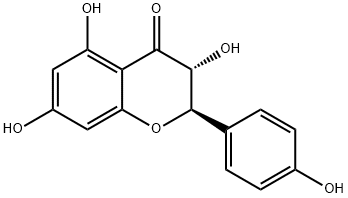480-20-6
中文名稱
香橙素
英文名稱
DIHYDROKAEMPFEROL
CAS
480-20-6
分子式
C15H12O6
分子量
288.25
MOL 文件
480-20-6.mol
更新日期
2025/02/21 09:58:49
 480-20-6 結構式
480-20-6 結構式
基本信息
中文別名
黃杞苷苷元二氫山柰酚
二氫莰非醇
二氫化萜醇
二氫山奈酚
香橙素,香樹素
香橙素(標準品)
香橙素(二氫山奈酚 )
(2R,3R)-3,5,7-三羥基-2-(4-羥基苯基)四氫苯并吡喃-4-酮
英文別名
Katuraninaromadedrin
AROMADENDRIN
DIHYDROKAEMPFEROL
(+)-dihydrokaempferol
DIHYDROKAEMPFEROL-CMPD
3,5,7,4'-TETRAHYDROXYFLAVANONE
Aromadendrin >=95% (LC/MS-ELSD)
AroMadendrin (DihydrokaeMpferol)
(2R,3R)-3,4′,5,7-Tetrahydroxyflavanone
所屬類別
天然產(chǎn)物:黃酮類化合物物理化學性質(zhì)
熔點237~241℃
沸點139-140 °C
密度1.599±0.06 g/cm3(Predicted)
儲存條件Sealed in dry,2-8°C
溶解度DMSO:2.88(Max Conc. mg/mL);10.0(Max Conc. mM)
酸度系數(shù)(pKa)7.42±0.60(Predicted)
形態(tài)neat
顏色White to off-white
InChIKeyPADQINQHPQKXNL-LSDHHAIUSA-N
LogP2.860 (est)
香橙素價格(試劑級)
| 報價日期 | 產(chǎn)品編號 | 產(chǎn)品名稱 | CAS號 | 包裝 | 價格 |
| 2025/02/08 | HY-N2897 | 香橙素 Dihydrokaempferol | 480-20-6 | 1 mg | 450元 |
| 2025/02/08 | HY-N2897 | 香橙素 Dihydrokaempferol | 480-20-6 | 5mg | 1100元 |
| 2025/02/08 | HY-N2897 | 香橙素 Dihydrokaempferol | 480-20-6 | 10 mM * 1 mLin DMSO | 1430元 |
常見問題列表
生物活性
Dihydrokaempferol 是從紫荊花 Bauhinia championii (Benth) 中分離得到的。 Dihydrokaempferol 誘導 apoptosis 并抑制 Bcl-2 和 Bcl-xL 的表達。Dihydrokaempferol 可以作為抗關節(jié)炎新藥的良好候選。靶點
Apoptosis; Bcl-2; Bcl-xL
體外研究
Dihydrokaempferol (0.3-300 μM; 48 hours) has no significant effect on normal synoviocytes, but dependently decreases the viability of RA-FLSs. Dihydrokaempferol (3-30 μM; 48 hours) increases the percentage of apoptotic cells (including early and late apoptotic cells; ~3.8% and ~9.6%, respectively). Dihydrokaempferol (3-30 μM; 48 hours) promotes Bax and Bad expression and inhibits Bcl-2 and Bcl-xL expression, increases the cleaved fragments of caspase-3, caspase-9 and cleaved PARP.
Cell Proliferation Assay
| Cell Line: | Normal synoviocyte cells; RA-FLS cells |
| Concentration: | 0.3 μM, 3 μM, 30 μM, 300 μM |
| Incubation Time: | 48 hours |
| Result: | Decreased the proliferation of RA-FLSs. |
Apoptosis Analysis
| Cell Line: | RA-FLS cells |
| Concentration: | 3 μM, 30 μM |
| Incubation Time: | 48 hours |
| Result: | Induced apoptosis in RA-FLSs. |
Western Blot Analysis
| Cell Line: | RA-FLS cells |
| Concentration: | 3 μM, 30 μM |
| Incubation Time: | 48 hours |
| Result: | Promoted Bax and Bad expression, increased the cleaved fragments of caspase-3, caspase-9 and cleaved PARP and inhibited Bcl-2 and Bcl-xL expression. |

